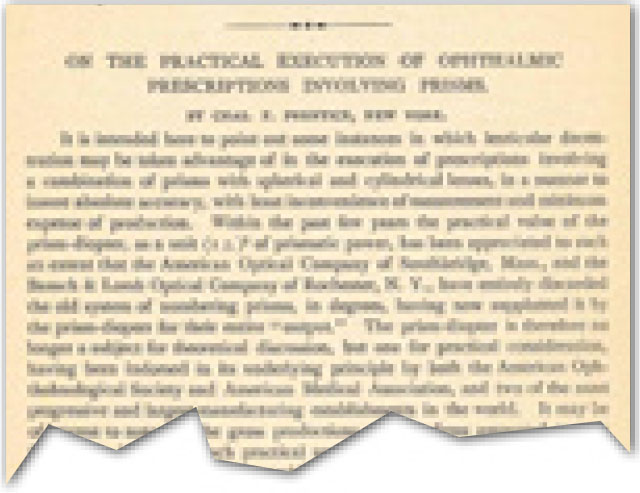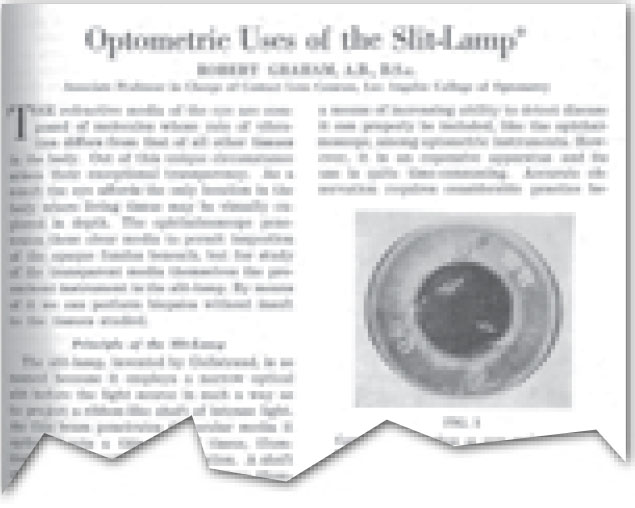 |
Peer into the history of optometry and you’ll soon see that its defining trait—reinvention—existed even before its name did. In 1891, when this publication was founded, the expertise needed to craft eyeglasses was mostly still found in jewelry stores and its practitioners went by the name opticians. While that name still adheres today to the professionals who create and dispense eyewear, the so-called refracting opticians of the late 19th century sought out ways to build up their skills in examining and measuring the eye. With their zeal to learn, educate and organize—as they set about building a profession of their own—they continually layered new skills and capabilities atop their foundation in optics, venturing ever further into the workings of the eye as an organ of the body.
Optometry, in all but name, was born.
So too was a publication just for its practitioners when The Optician debuted in January 1891, the brainchild of founding editor Frederick Boger of New York. Boger knew that the great minds of his time, people like Charles Prentice and A. Jay Cross—two of optometry’s founding fathers—needed an outlet for sharing their ideas, and practitioners struggling to make a go of private enterprise needed concrete advice from the experts.
“The textbooks are excellent enough in their way,” Boger wrote in our debut issue. “But they treat more with generalities than with actualities.” By contrast, this publication “has the advantage over the textbook in knowing all that the textbook has taught and applying that knowledge to daily occurrences.”
There you have it: identifying and solving real-world problems has been in the DNA of the magazine from its very first issue. Roughly 2,000 issues later, we’re still just as dedicated to that mission statement.
 |
| Charles Prentice, a key player in the creation of optometry, contributed to this publication’s earliest issues, as seen in this 1895 article on his innovative system of prism diopters. |
Shifting Sands
The late 19th century was a time of rapid development for optometry, wherein many of the pillars of today’s profession came to be.
Boger and Prentice, along with Charles Lembke and others, went on to co-found the AOA and advocate for the advancement of their new profession. An early priority was lobbying legislatures to enact optometry laws that recognized and codified the profession. In 1895, Prentice was even threatened with jail time for charging an exam fee, which was construed as practicing medicine without a license.
 |
Boger and others (notably John Eberhardt) lobbied to call the practitioners optometrists. Prentice was a hold-out. His preferred term, opticist, never took off.
Cross took up the cause of optometric education and the founding of dedicated optometry colleges.
All the while, this publication was evolving, too. Just four years after its debut, The Optician changed its name to The Optical Journal, likely to give it a sense of gravitas appropriate to the pursuit of professionalism that marked this period, as practitioners dearly wished to be thought of as more than mere “spectacle peddlers.” That spirit of ever-greater professional aspiration has been a hallmark of optometry since its inception and persists today.
 |
| Early adopters of the new optical correction of contact lens fitting helped push optometry’s medical development forward, as it compelled advancement of their skills into evaluation of the ocular surface. This 1951 overview of the slit lamp introduced the device and its uses. |
You can also trace the rise of optometry in this magazine’s logo designs through the 20th century (see sidebar, previous page). In 1910, its name was extended to The Optical Journal and Review of Optometry. Then, over the course of several decades, the “optical journal” aspect was progressively downplayed in the design and dropped entirely in 1977.
Editorial coverage likewise perpetually shifted to the next set of clinical skills and opportunities for ODs, with proponents of scope expansion arguing vociferously in these pages for things that now seem absolutely essential, like use of dilating drops, a controversy in its day.
Meeting the Moment
And today? After a tumultuous year of pandemic and controversy, we’re all eager to turn the page. For our 130th anniversary, we’ve given the publication a front-to-back redesign, marked by an aesthetic that’s clean and uncluttered.
 |
| Ads through the years chronicled fashion trends in eyewear, clothes and design. |
Later this year, our website will be reorganized around editorial topics more so than issues of the publication, owing to the lasting value of the articles published herein. We want to make it easier for you to find and enjoy the breadth of expertise your peers share in these pages even after print issues have come and gone.
We’re also pushing forward in an effort to diversify our authors and board members, always on the lookout for the next generation of great thinkers and innovators who’ll continue to carry the profession forward.
In our debut issue of January 1891, Boger pledged that the publication would “be for its readers a fountain-head of reliable information—a monthly visitor, in whose columns will be found a clear exposition of all the latest ideas and suggestions.” That principle has guided us ever since.
As we have been for 130 years, we’re excited for what comes next.
A Message From Our PublisherWhile the first few months of the new year may, in fact, seem a great deal like the last several months of the old year—we have, if nothing else, a renewed sense of hope and optimism that 2021 will mark a stark turning point in humanity’s battle against the COVID-19 pandemic. Fortunately, during the past 10 months, we’ve all continued to experience precious moments of accomplishment, reward and joy—even if these instances frequently have been dotted with a Mark McGwire-sized asterisk. Perhaps a son or daughter graduated from college (*just two family members were permitted to attend). Or, you purchased a new home (*but had to tour the house virtually). I, too, reached a new milestone last year. In July, I was humbled and honored to be named publisher of the Review Group, following the retirement of my predecessor, mentor and friend, Jim Henne (*during one of the most turbulent times our industry has ever faced). Throughout this period of enormous uncertainty, however, we’ve remained steadfastly committed to the development of novel, practical content intended to help you successfully navigate these trying times. And, I couldn’t be more proud of our efforts. Along similar lines, I’m pleased to announce that Review has undergone its most comprehensive graphic redesign in over 20 years. You’ll notice a bold re-imagining of our logo on the cover, and a modern aesthetic layout for feature articles and recurring columns. It’s all part of our tireless efforts to provide you with leadership in clinical care—which also happens to be our new tagline. —Michael Hoster, Publisher |

